I spent a month in Oaxaca city and environs during October and November 2012.
The Oaxaca photo gallery contains photographs of Oaxaca and bird/natural history photographs from the area. See my Ancient Peoples Website for photos of artifacts and early history sites from the area.
During October-November 2012, I recorded video in the state of Oaxaca, Mexico. The general human cultural history of the area is included in the following video:
I arrived in Oaxaca city Saturday night and had a leisurely breakfast Sunday morning at the hotel. Good coffee and breads. A "race for health" was occurring a few feet away, joggers of all shapes and sizes running along cobble stone streets. Following breakfast I relocated to the place I stayed at for the rest of the trip and spent the afternoon visiting markets and city parks.
I birded Monday to Thursday. The guide (Eric Antonio Martinez) I arranged for picked me up at 6 a.m. each morning and off we would go, arriving at our birding site at dawn. I was working on video of Mexican endemics so I am not sure what the sighting counts were for each day. Eric says that we saw 94 species on Monday. I tried to ignore the migrants from the north, it was easy in some cases (Barn and Violet-Green Swallows, Turkey and Black Vulture, Cassin's and Western Kingbirds, etc) and difficult in others (various warblers with males still in alternate plumage, Townsend's, Hermit, etc.). The most common hummingbird here at the moment is the Ruby-throated, Eric said they disperse in a month but will congregate again before the migration north.
We averaged over 11 hours of birding a day, with the longest being about 13 and the shortest about 9 (the last day - I simply ran out of steam [or is that I ran out of hot air?]) We spent a total of 8+ hours at 3 different locations trying for video of Ocellated Thrasher (a range limited to south-central Mexico). A number of those hours were spent along ridge lines being very cold (undershirt, thick flannel shirt, and fleece were not enough), waiting for the sun to hit us, and murmuring about Thrashers being very easy or very hard - nothing in the middle. At the last site they were in plain view, in the sun, and singing.
Tuesday morning we spent four hours trying for video of Dwarf Jay (range limited to parts of Oaxaca, Puebla, and Veracruz) and then only in pine-oak forests, we were working at about 9,000 feet. It apparently eats an insect which is found in the moss that grows on large trees in the area. I managed some video of the feeding behavior, the bird was pretty far away so the image size is not great. However, this may be only the second video of this species, the first from 2009. Frame grabs may represent the best photo of this species yet. The accuracy of all of those statements will require verification, which I will start shortly. It is not an easy bird to work with.
While the 5 to 10 seconds of video I managed of the Bumblebee Hummingbird took two hours of work the video of an Amethyst-throated Hummingbird happened because if landed in front of me while I was trying for Mountain Trogon (poor video). The Amethyst-throated has a range limited to central Mexico south to Nicaragua.
I thought the Bumblebee Hummingbird name came from its size (it may be the second smallest bird - only the Bee Hummingbird of Cuba being smaller), but no - it sounds like a Bumblebee when it is flying around. The Bumblebee Hummingbird is a Mexican endemic while the Mountain Trogon has a range like that of the Amethyst-throated Hummingbird. (I think the Bumblebee Hummingbird has been a vagrant to Arizona.) The Dusky Hummingbird (endemic to SW Mexico) proved relatively easy to video - for a hummer.
Several hours over two days were spent on video of the Grey-breasted Woodpecker (endemic to interior SW Mexico) and less than 20 minutes was spent videoing a House Finch on a cactus. The House Finch sub-species which is found here is strongly marked and very bright, the head coloration being a distinctive hood.
I recorded a White-throated Towhee, a species which is endemic to the the interior regions of southwest Mexico, on the slopes leading up to the Monte Albán archeological site. The Rufous-capped Warbler, another Mexican endemic was videoed north of Oaxaca city.
I was able to video three species of Woodcreeper: White-striped (endemic to the mountains of W. Mexico), the Spot-crowned, and the Strong-billed -- all without much incident or effort.
I videoed Boucard's Wren (endemic to SW Mexico) at two different sites without a huge amount of effort (photo right). The video I have of the Grey-barred Wren (endemic to the mountain forests of central Mexico) is marginal because of back-light -- Grey-barred Wrens and Dwarf Jays often travel together so the time spent on the Wren and Jay was concurrent.
I will not bore you with others, other than to note that I saw but failed to tape several nice species, including Berylline Hummingbird, White-eared Hummingbird, and Red Warbler.
While Spring is a better time for birding this is the time for flowers - many species and many individual plants are in bloom.
Earlier, I mentioned that the guide I used while birding in Oaxaca was Eric Antonio Martinez. I recommend Eric without reservation. He is a knowledgeable birder and guide (and the two are not the same) and is fluently bi-lingual in English and Spanish.
Working on video of bird species is significantly different from birding or bird photography. It is just as hard on the people around you as it is on you. While I find myself fussing with a tripod on uneven ground, sometimes just managing to see through the viewfinder can be a chore, and trying to focus on a bird in a tangle of vines when there is a very limited field of view and everything looks the same (no reference points to let me know where to have the camera pointed), the person I am with is standing around trying to be quiet. That is hard, especially when it takes hours of work for a few seconds of good video of a species. For a guide who has been trained by numerous clients to sight a bird and then run off to find another species, it can feel terribly unsuccessful. What I find myself saying most are things like, "No, I missed it", "Where?", "Did it fly?" Statements that I don't like to make and guides don't like to hear. As a result, I must say that most of the guides I have worked with are only marginally good at providing video support.
Eric proved to be an exceptional guide. I suspected as much on the first morning when, as we drove through the dark to the first birding site, he inquired extensively about what I wanted to happen, how I wanted him to provide support, how we would approach the effort, etc. No assuming that he already knew what was in my head. Although we had corresponded by email on the topic, he wanted to make sure that he knew how he could provide the best client support possible. As a result, I found him very easy to work with and came away feeling that this was a very successful venture. I hope to be back in Oaxaca again - and maybe Chiapas - and will be planning the timing of the trip around Eric's availability.
To say that my trip to Oaxaca was one focused on Mexican and primarily southwestern Mexico endemics, like the Boucard’s Wren above, is absolutely true but it doesn’t tell the hope. As always I hope to spend a hard day with the video camera and obtain an hour of video. A more common day is a half hour of video with 45 minutes being a very good day. Of that video, at least 50% should be useable, but in the end not necessarily used. A hour of tape a day would have allowed me to video all of the endemics and move on to the birds with a slightly wider range. In all the success rate in terms of video was about average and I was able to video most of the birds which are endemic to southwestern Mexico and found in the Central Valley of Oaxaca - and a few other species as well.
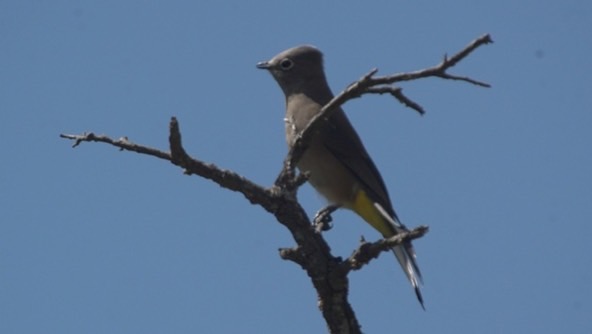
The Gray Silky-Flycatcher (Ptilogonys cinereus), photo above, is endemic to Mexico and Guatemala and turned out to be a rather cooperative bird. It was traveling about in flocks and tended to stay put when they had found a productive food source. I was struck by memories of the Long-tailed Silky-Flycatcher which I have videoed elsewhere - primarily in Costa Rica. Although the birds of this genus eat insects, and exhibit the typical flycatching behavior, they are generally associated with mistletoe and eat the berries. The member of this genus which visits our yard, the Phainopepla, is generally found by call and by looking for mistletoe clumps in the cottonwoods.
Is it possible to think of the Great Kiskadee (Pitangus sulphuratus), shown below, as a favorite bird? Not sure about the answer, but I do know that if you bird the American tropics you need to learn this bird and learn it well. It is found throughout the American tropics and there are several species which look very similar. In Mexico, the look-a-likes are limited to the Boat-billed Flycatcher and the Social Flycatcher. In South America these species are joined by a host of others, including the White-ringed Flycatcher and the Rusty-margined Flycatcher.
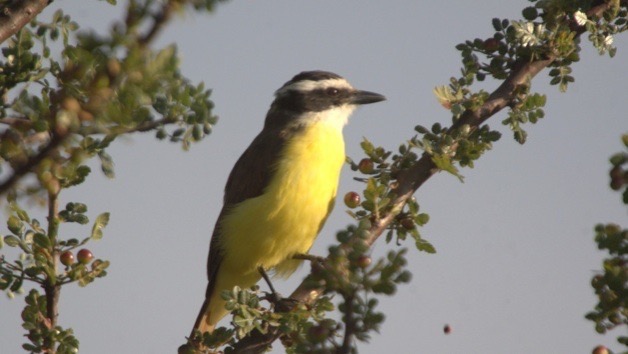
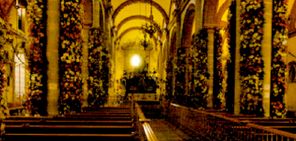
But my activities in Oaxaca were not exclusively associated with birding. I wandered about the old part of Oaxaca City a great deal. On one occasion, I walked into the Cathedral of Oaxaca (Catedral de Oaxaca) at the Zocolo in Oaxaca City expecting to see one more cathedral, one more set of columns, more stained glass, and more religious relics. To an untrained eye, like mine, they all look amazingly the same.
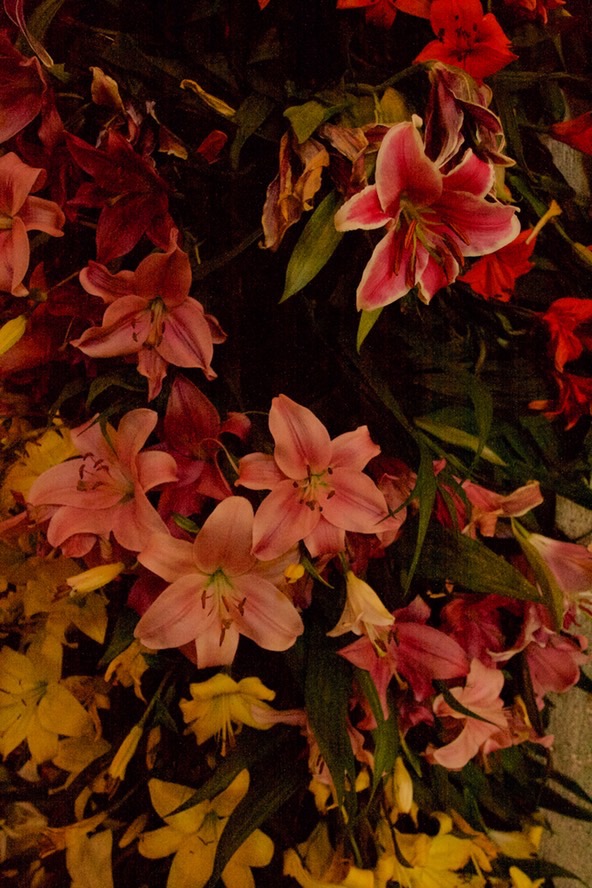
What I saw instead was a glory of flowers, lilies to be precise. Lilies of many colors covered all of the columns; it was breathtaking, completely unexpected, and wonderfully marvelous. It was, however, difficult to photograph, very dark and without a single reference point to capture the grandeur. Instead of one photograph, I have opted for three hoping to give an idea of what the experience was like.
After photographing the lilies I walked outside to watch young dancers in indigenous dress. I had a lot of fun photographing them, showing them the results on the camera's LCD screen after each shot. They had a ball, I had a ball, there was a lot of laughter -- amidst the watchful adults.
Later in the day I walked through several of the markets that are near the Zocolo. I tried doing some video in the Mercado Juarez/20 de Noviembre market (named for the street it is on), but my first attempt was not very successful. The colors of the market are overwhelming, originating from everything from fresh fish and plucked chickens to flowers of many shapes and hues. Along the way there are mescal, papaya, bread, purses, bags, cheese, bananas of various types.... The market is indoors and covers an entire city block. The streets surrounding the market are a mass of stalls which replicate the inards of the market, and across the street is a market of the same size which is composed mostly of food stands. It was there that I had my first marginal food in Oaxaca - leathery tortilla and meat (but nice taste).
I added to my top collection along the way. Over the years I have collected spinning tops to remind me of my travels, and the ones here are very colorful.
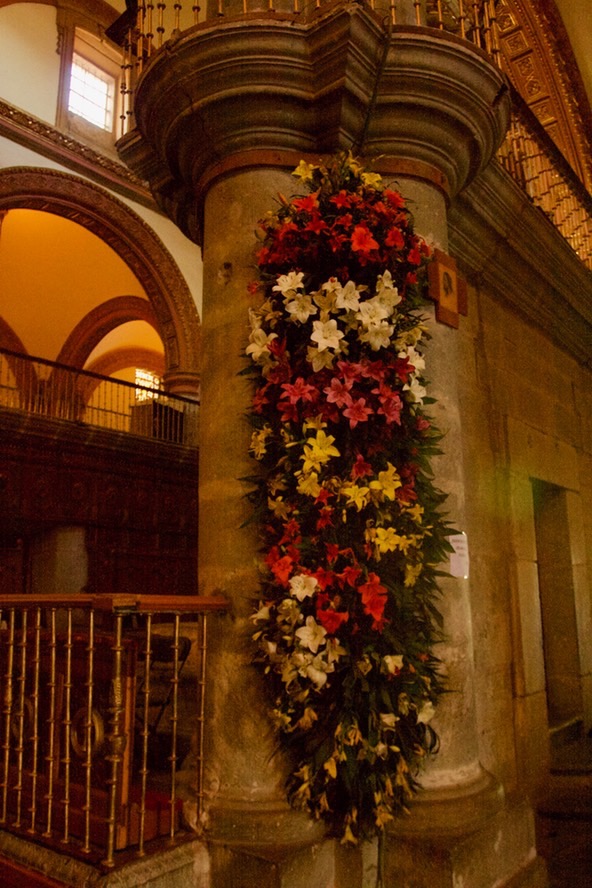
Every once in a while I run across a discussion of Fine Art and whether or not Folk Art (handicrafts, etc.) can ever be considered Fine Art or are forever regulated to a lesser dominion. The arguments for exclusion vary and I have never considered the argument for or against worth making; they are simply different.
Yesterday, I visited the Zapotec village of San Martin Tilcajete where we visited the workshops and gallery of Jacobo & Maria Angeles. They specialize in the carving of fauna, some quasi-natural, some most definitely supernatural, works which are called alebrijes. The works are made from the wood of Copal, Bursera glabrifolia or perhaps Bursera bipinnata, the former referred to as male Copal and the later as female Copal. Work from these workshops has been displayed at The Smithsonian, The National Museum of Mexican Art, and similar museums and galleries around the world.
Many of the works are magical combinations of beasts carved from a single piece of wood. The completed carving is both intricate and reflective of the combined traditions of Zapotec and Oaxacan Catholic cultures. Most of the carving is done by men in the village.
Works produced at this gallery are then painted in either acrylic or natural paints. While we were there we watched a demonstration of how several colors are derived, using various combinations of Copal, zinc, calcium, indigo, and lemon juice (citric acid?). This natural palette is shown to the right. Other colors are derived from other natural materials from the area.
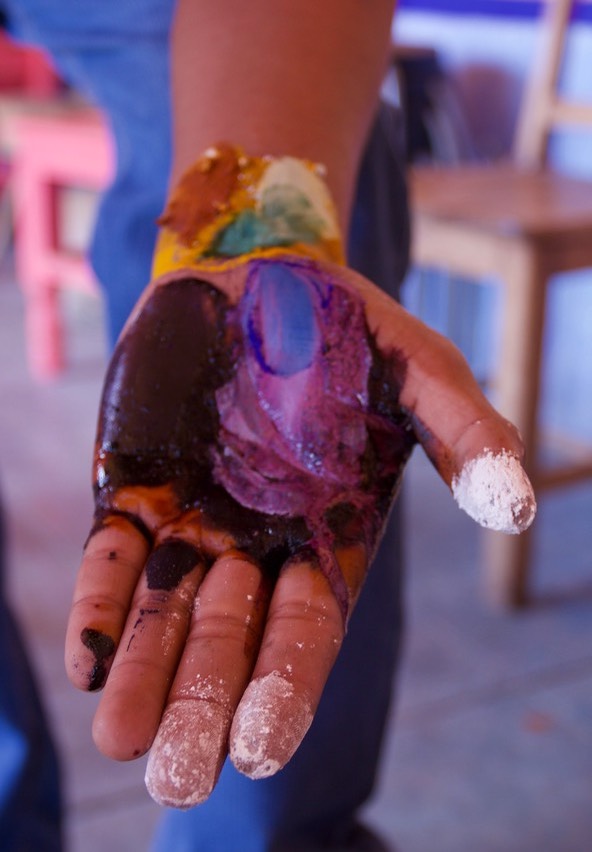
On reflection I wish that we had a place to display some of the works I saw in our home and the willingness to spend the asking price on such beautiful works of Art. They are as evocative and representative of cultural concepts as any piece of European Fine Art.
We also visited the Zapotec village of San Bartolo Coyotepec to see a demonstration of how Barro Negro Pottery is made at the Doña Rosa Workshop. Pottery made from the materials used today has been found at the Monte Alban archaeological site. Pottery from Monte Alban, and the traditional pottery of the area today, is typically colored a gray-matte, has a metallic ring when struck, and is impervious to water - adding a utilitarian factor to its inherent beauty. In the 1950's Doña Rosa Real discovered a polishing technique and a modification to the firing process that resulted in the highly polished black pottery of today. The family of Doña Rosa Real carries on the tradition of innovation at the Doña Rosa Workshop. While there we watched a demonstration of the clay working techniques used in the area.
Monday evening we took a tour of the Oaxaca Ethnobotanical Garden, which is only three blocks from where we are staying. It is part of the Santo Domingo Monastery complex which dates from the 16th century. The Garden was established roughly twenty years ago, when the military, which had occupied the monastery for 120 years, left the premises.
"One-hour" tours of the garden are scheduled at regular intervals and are available in Spanish, English, French, and some other languages. Although you can see major portions of the gardens from the galleries of the monastery which overlooks it, these tours are the only way to see the gardens up close. To say that the tours are an hour is a bit of a misnomer - the guides always seem to be in a hurry. In Spanish, the tour is $50 pesos per person, in other languages it is $100 pesos per person. But in any case, it is well worth the expense - whatever the length. Francisco Toledo, one of Oaxaca's favorite sons, was instrumental in establishing the gardens and in helping ensure their success. Some of his sculpture is integrated into the plantings.
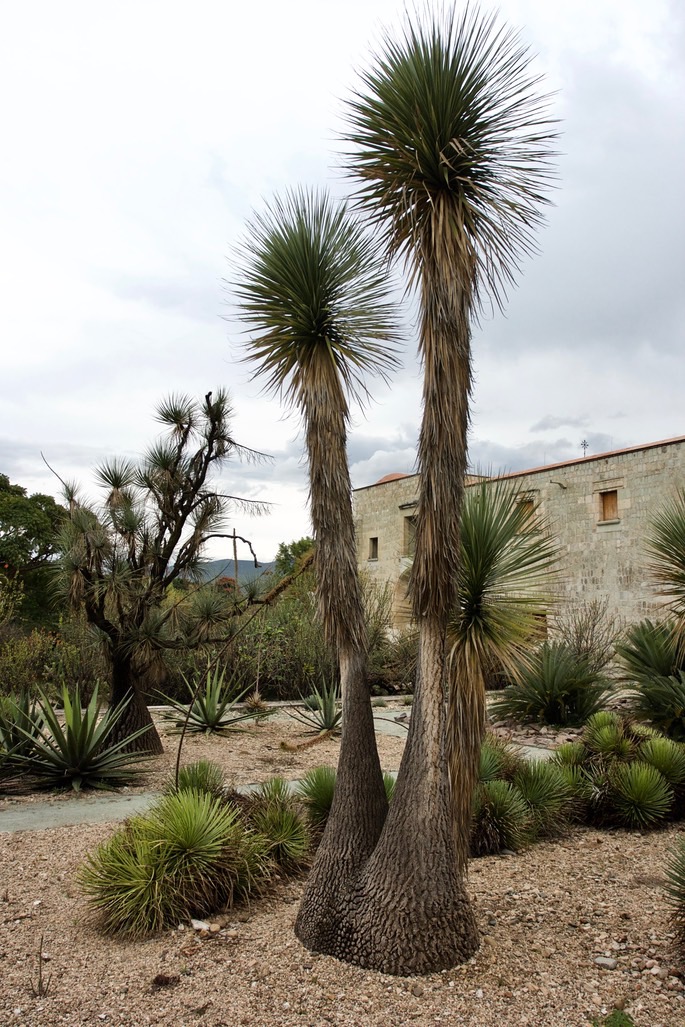
It is difficult to believe that the garden is so new; mature cactus and trees are everywhere. As the name indicates, the plants are all native to Oaxaca and all are features of the Oaxacan culture. The setting is dramatic: The garden is completely enclosed by garden walls and the walls of the monastery. A path winds in and out of the plantings, and with each turn there is not only a new set of flora to see but a new view of the monastery.
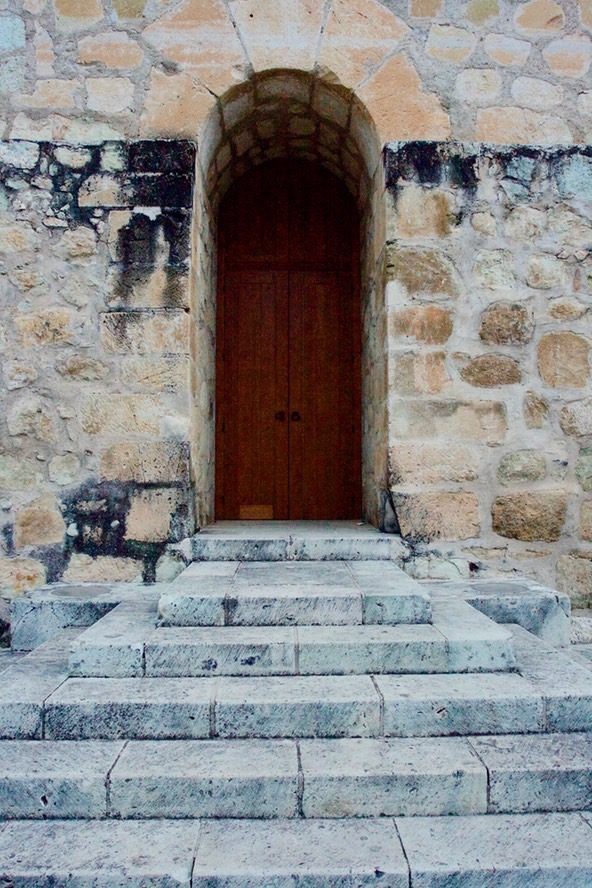
The monastery is now the venue of the Museo de las Culturas de Oaxaca, a nice museum in a setting which adds to its prestige. The museum has displays which cover more than two thousand years of local history. The major exhibit is a collection of artifacts from Tomb 7 at Monte Albán. The Tomb is from the Classic Zapotec period but was used by Mixtec elites at a later date.
The gardens offer a wonderful space to present and conserve Oaxaca's flora - from the grand in scale to the small. The monastery mimics that range of scale nicely and is a wonderful backdrop to the plantings.
Tuesday and Wednesday were days for kids' parades, anticipating the adult parades for Day of the Dead Thursday night here in Oaxaca. As I walked about town, I saw eight such parades, and my survey was far from comprehensive.
Generally, the parades were sponsored (in part?) by the schools the kids attended. One defining feature of the parade: more adults than kids, since each kid seemed to need at least three watchful adults.
Every parade had its own band, some larger than others, some obviously more well established than others, but all were loud and all featured tubas. The parade song seems to be standardized, and as you might guess, the tubas really get into it.
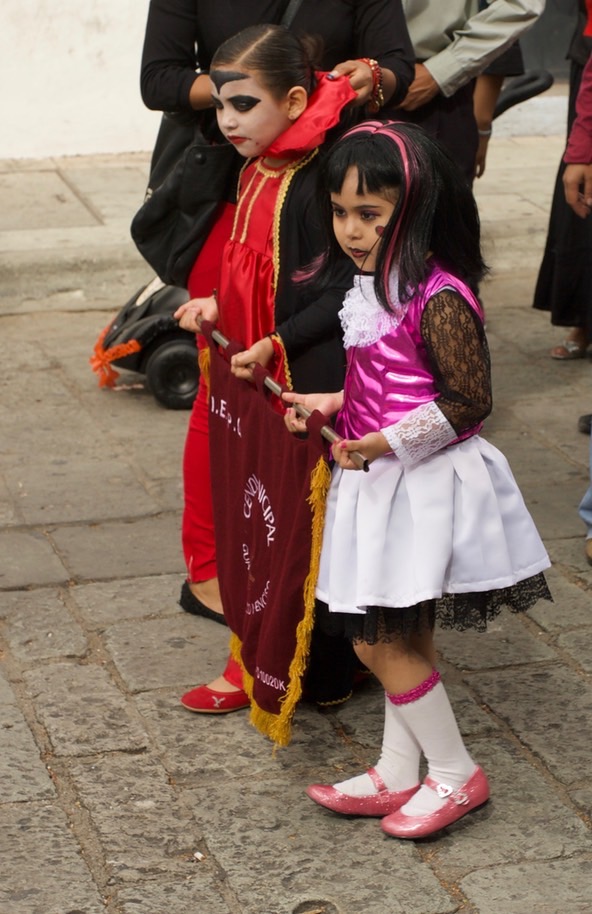
Certainly on Tuesday it appeared that the adults were having more fun than the kids. Fanciful costumes, all centered around the morbid, adorned each child but generally they shuffled along looking somewhat bewildered while their guardian adults jumped around and encouraged them to be happy and active.
The kids in the parades on Wednesday tended to be older than the Tuesday kids (photo right) and more animated.
A number of arches line the street (Garcia Vigil) just north of where we are staying. They are the remnants of an aqueduct from San Felipe to Oaxaca City.
Just to the north of town is the 10,200 foot Cerro San Felipe, one of the peaks in the string of mountains which encircle the Central Valley of Oaxaca, and a source of fresh water for the city until at least 1940. In the 18th century (around 1751), the five-mile aqueduct was built from what is now San Felipe del Agua to a cistern at the Carmen Alto church (which is across the street from where we are staying). Water distribution systems have always been central to development, and the Spaniards brought their (Roman) expertise with them to the Western Hemisphere. This aqueduct is not as grand as the aqueduct in Segovia, Spain, but is a beautiful and integral part of the city rather than looking sadly out of place.
The aqueduct stopped being used shortly after 1940, but instead of being destroyed it has, for the most part, been incorporated into the structures and infrastructure of Oaxaca. The openings which are created by the arches are sometimes blocked off, sometimes they are points of ingress or egress for narrow and colorful lanes, and sometimes they are the portals of homes.
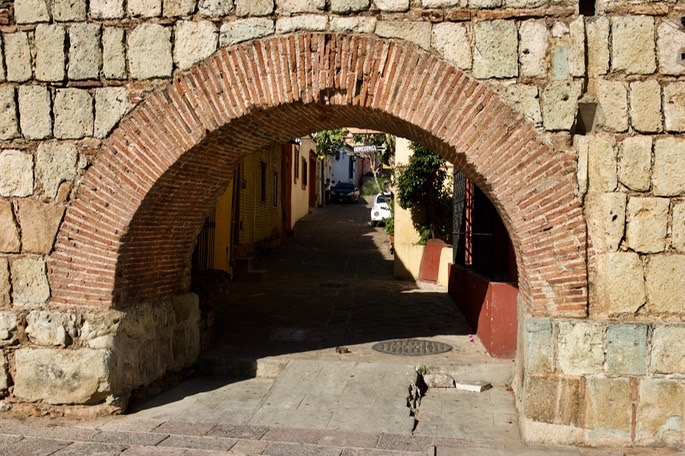
Can you say, "drunken festival with fantastical costumes and people having a really good time?" For shorthand, you could say "Etla - 1 de noviembre". Last Thursday night we enjoyed the Day of the Dead tradition called Comparsas at Etla in Oaxaca and a nearby community. The costumes were elaborate, colorful, and dutifully morbid or from a fantasy nirvana.
The bands were loud, the photographers were everywhere (and the costume wearers were very cooperative), there was lots of food -- it was Carnival. Comparsas are events of evolving definition. They are based in the cultures of the Catholic Church and the indigenous peoples of the area (in this case Oaxaca) but they continue to morph into something truly and uniquely Mexican.
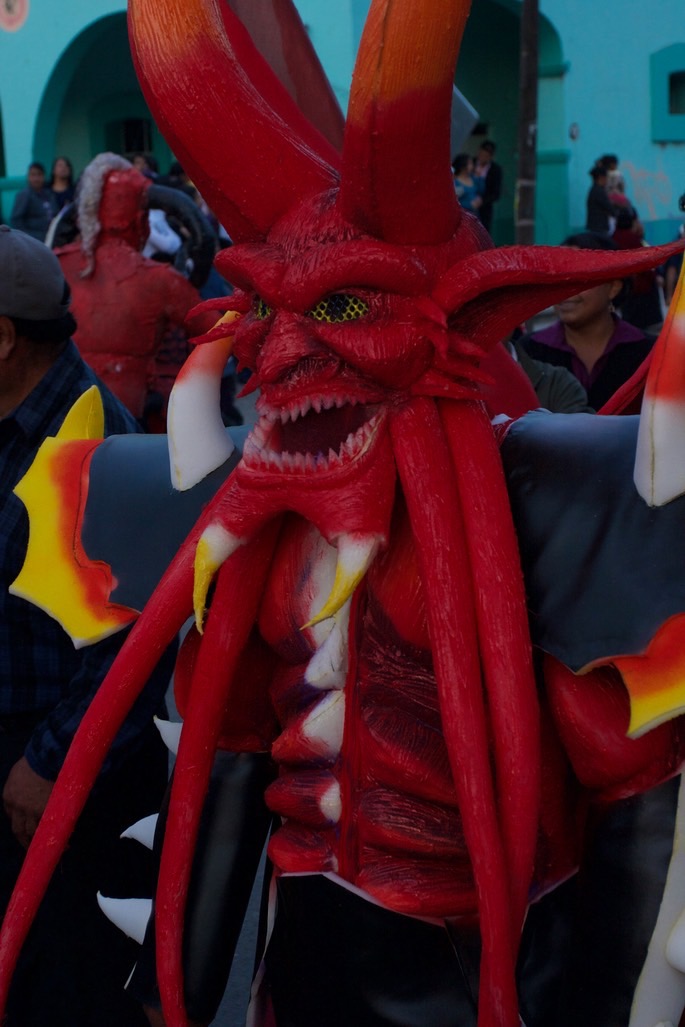
Traditionally the costumes are worn only by men, and it is almost exclusively men who wear the large and elaborate carnival dress and men who are in the mosh pit formed by the onlookers. The heat of the costumes, the adrenaline from the mosh, and the beer make for a very rambunctious crowd.
The fringe of the mosh is composed of on-lookers both adult (many of whom were using camera phones, tablets with camera, and cameras) and young who are often in costume, regardless of their gender.
The band played with enthusiasm, and given that tubas require a fair amount of energy to play -- and they were played loudly -- must have been exhausted in a short while, but they kept up the hypnotic beat generated by lots of horns and a few drums.

Toward the end of the evening, I saw one of those personal encounters that tour companies never mention. A young man, quite obviously drunk, had drawn the attention of a policeman. (The police, of whatever ilk, travel in groups of at least three and many of them carry automatic weapons.) The police were ready to haul the young man off to jail; the boy's father had interceded, pleading with the police and wrangling with his son, who wanted "to get it on". It was a sad scene. The father was obviously quite frightened, and given Mexico's (recent) history of "the disappeared" perhaps rightly so. The old man finally put enough space between his son and the police to avoid continued confrontation, members of the crowd, some of whom seemed to have some authority, interceded on the youth's behalf, and the two groups separated -- or more correctly the police decided not to exert their authority and the father exerted his in the form of a head and hammer lock - the father and son melting into the crowd.
Colors abound in Oaxaca, clothes and costumes, walls and doors, sand paintings and murals, and all are bounded by beautiful rock and stucco. It is as if the city were a huge canvas that the people had decided to make their own, describing themselves and their culture in a work of art. (Below - Streets and squares are a canvas for sand paintings.)
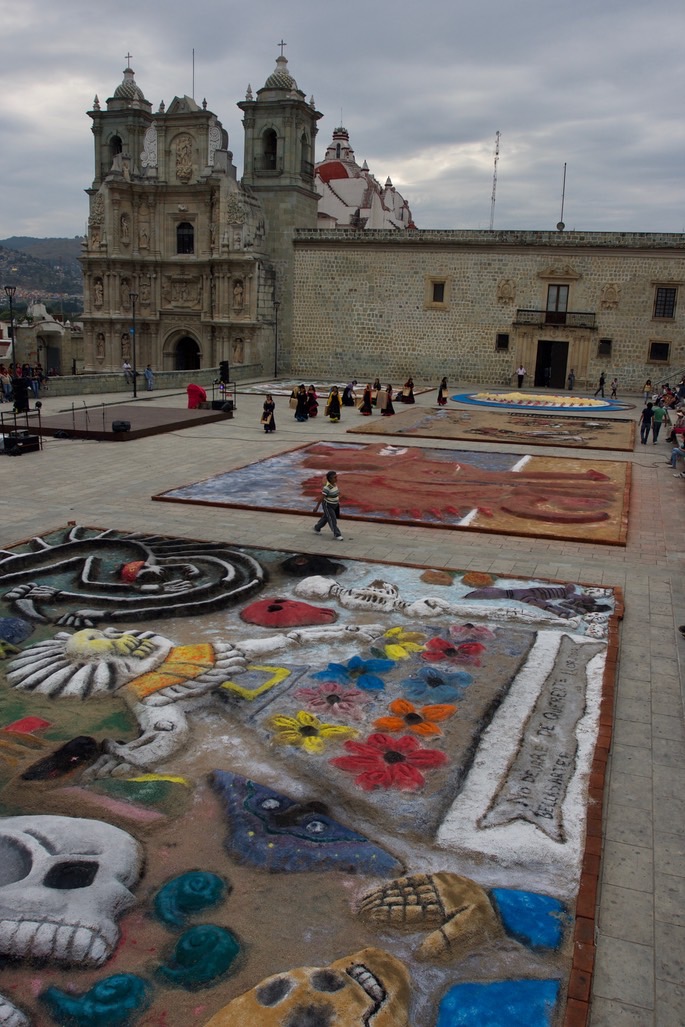
I speak here of the old part of town; the new part of town is typical urban sprawl. Loud, congested, with air full of diesel and other toxic smells.
In the old part of town things have had time to meld into a huge mural which is striking in texture and color. For instance, I have found myself looking at doors a lot. Some are colorful, a bit of striking color framed by huge stone walls. Others are rich and mellow in texture and tone, creating a wonderfully different image and evoking a completely different feeling.
Even the street vendors add color and texture to the scene. Suddenly a rather drab curb or door stoop becomes a bright spot of color, texture, and design - but if you look at the spot too long, it will result in an aggressive sales pitch.
As we wandered home from looking at sand paintings on Saturday night, we stopped to listen to publicly performed music and dance near the Church of Santo Domingo de Guzmán. The photograph of Oaxacan dancers (below) is a byproduct of a very enjoyable time spent sitting on the wall by the church watching the entertainment from "backstage". As I watched the dancers and mulled over the type of image that would be interesting, and how I would achieve such an image, a young boy sat on the stage and batted his helium ballon around - spending his time watching the dancers in front and the people milling in back, and distracting me from my effort for quite awhile.
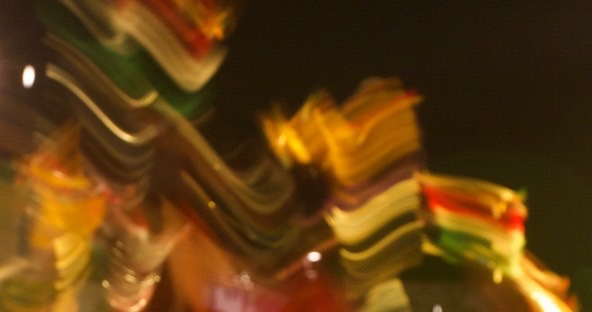
In the narrow lanes where the color of houses turns the public thoroughfare into a kaleidoscope, the walls may be covered in murals or at times with graffiti, which to an outsider manages to be colorful rather than annoying.
One of the glorious side benefits of birding in the tropics is the fruits and vegetables which can be found in the markets, on the trees or vines, and on your plate. Some are known to me, some are unknown. Some are available in the United States from time to time, in varying degrees of ripeness - but mostly rock hard (never to ripen) or significantly beyond their prime, and some are not available at all.
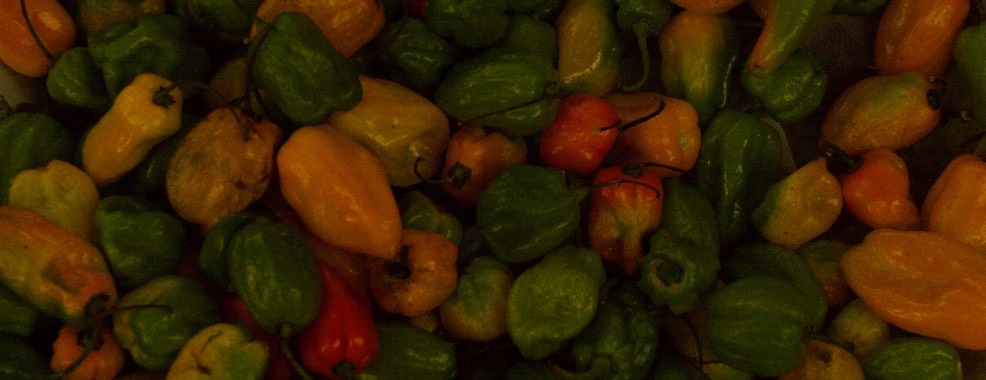
As we cruised through the 20 de Noviembre Market a few days ago I was struck, once again, by the sights and smells of the fruit and vegetable displays. Sometimes, especially in Mexican markets, there are a lot of prepared foods as well - cheese, mescal, and moles of many varieties, for example. And chilies, lots and lots of chilies - fresh, dried, or prepared - of myriad shapes, colors and sizes, lots of chilies.
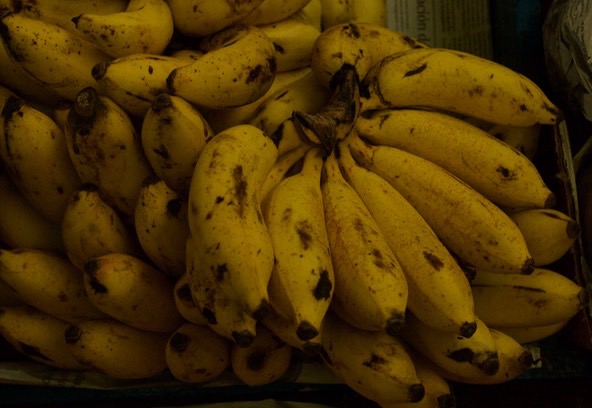
I read recently that as the world warms, bananas will become a staple for more and more people. Depending on how the measurement is done, bananas are already one of the top four or five food sources for humans. You would not know it from an American supermarket, but there are many varieties of banana. Every market in Oaxaca currently has a small banana which reminds me of the banana that we called "lady finger" when I was in middle school in Puerto Rico. They were so good, so much better than the northern supermarket form. And, true to type, the small bananas here are also great.
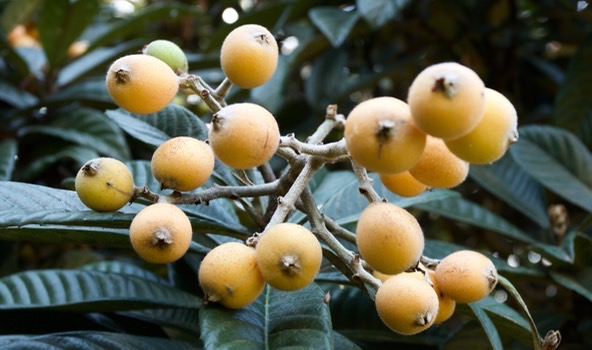
A fruit which is available in the markets here and which I had not encountered before, the loquat (nispero in Oaxacan Mexican), apparently grows in some of the southern reaches of the United States (photo right). It has an exquisite taste, grows on trees, and has a fairly high seed to pulp ratio (although the seeds are large for the size of the fruit and thus easy to deal with).
The wonder of it all is that in every trip south I seem to find something new, delicious, and exotic. I must keep birding - it is such a fruitful endeavor.
By Oaxacan churches I mean Catholic churches. Not only are they the most numerous - one every few blocks - but they are some of the most beautiful religious structures in Oaxaca. I am not a person who admires gilt and the ornate interior of many churches - it is something that I consider vulgar - but the exterior of the buildings and the architecture of the buildings (even those of baroque style) can be very striking.
The acoustics in these churches are (almost universally) excellent. Several times of late I have stood in large Catholic churches for the sole purpose of listening to the resonance of the mass. It reminds me of a time decades ago when I stood in the balcony of St. Mark's Cathedral in Venice and heard mass there. It was the first time that I truly understood what strong emotions mysticism can invoke and how important a role it plays in religion. There is something to entrances which adds to the mysticism. They are portals in huge stone edifices which form the transition from the light outside to the dark mystical interior, full of smell, deep rumbling and soft subtle sound - very much like a cave. It is primeval, reminding us of our past way beyond 6,000 years ago.

There is no doubt that Catholicism plays an important role in the lives of many Mexicans. A number of the people who walk by church entrances make the sign of the cross. Although most masses, it seems to me, are only sparsely attended, there are some which overflow the church.
The Catholic Church practice of incorporating local beliefs and practices into its own ceremonies is probably the most successful tactic it has employed in converting non-Catholics to Catholicism. In Oaxaca the integration of the beliefs, practices, and ceremonies of the Catholic Church and the religious systems of the Zapotec and Mixtec is apparent in every parade and on every holiday. The integration of those belief systems adds enormously to the culture of Oaxaca.
Here, I show two images from buildings currently or formerly associated with the Catholic Church. The relationship between the Catholic Church and the government of Mexico has been troubled. As a consequence, some structures formerly owned by the Catholic Church are now owned by the public.
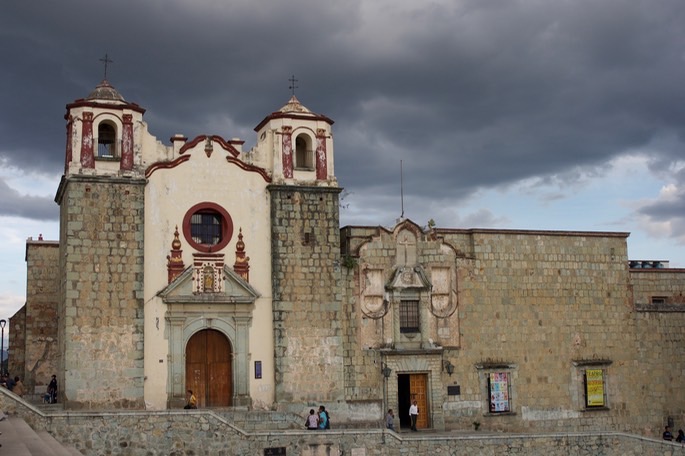
Instead of some of the grand facades, I often search out the side entrances. They seem to me to be more evocative, more beautiful in their (relative) simplicity. And the corridors of former monasteries form a mosaic of light, color, and texture which I find difficult to ignore.
On Tuesday I traveled to Monte Alban to video birds and incidentally view the ruins. I was stopped from taking a tripod onto the grounds. Birders who may wish to use a scope or take long range photography at Monte Alban - and most other major archaeological sites - will find that it is incredibly difficult to impossible to do so. Effective use of your time and resources would dictate that you bird and photograph elsewhere.
I have not run across something like this since I was told by a curator at Western New Mexico State University that I could not take photographs of Mimbres pottery (dating from 150 to 1450 AD) because it was protected by copyright.
Speaking of the policies of the Mexican government, I have been struck by the almost complete lack of any serious environmental commitment here, much like the Trump administration. By far the most effective efforts I have seen are those taken by individual communities in the mountains which are trying to hop on the eco-tourist bandwagon (and their idea of eco-tourism is heavily weighted to the mountain biking concept). In any case, environmentalism and Mexico are not words that go easily together in one sentence. All you have to do is smell the river that runs through Oaxaca City to understand what I mean.
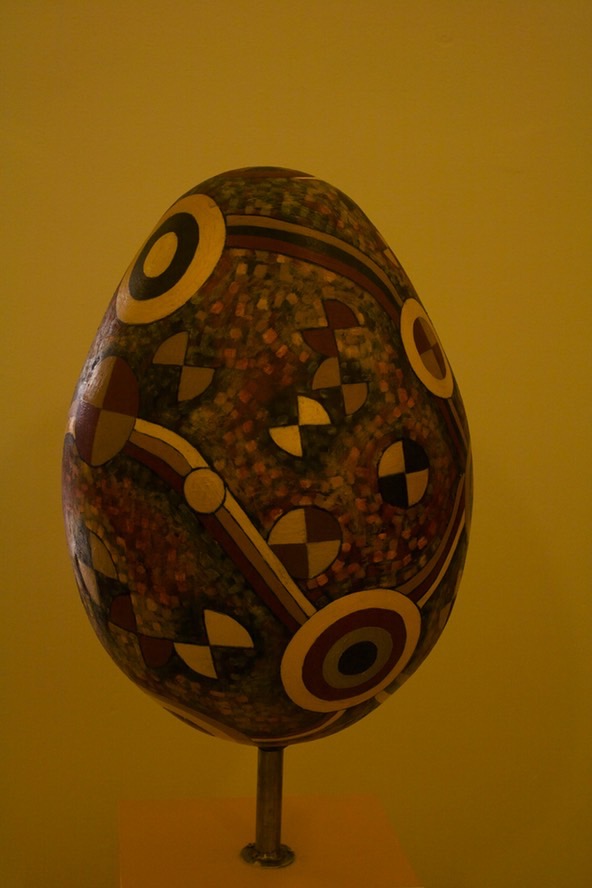
Saturday was our day to visit art galleries in Oaxaca City. First on the list was the Museo de Pintores Oaxaqueños (Museum of Oaxacan Painters). There was one painting by Rufino Tamayo that I liked, but mostly I liked the floors and doors, they were made of beautiful wood.
Next on our journey was the Museum of Contemporary Art where I particularly liked the rock guitarist who played on the street outside.
Next up, the Museo del Palacio where Arturo Garcia Bustos (b. 1926) has painted two murals. Otherwise, the museum had displays of photographs (several of which were quite good), paintings (likewise), and a modern art display which included a flat surface painting beside a large egg with the same image painted on its surface.
The buildings which housed the exhibits were all quite nice and worth the visit. The Museo del Palacio is located in the state government building. As is often the case, the main entrance was blocked by demonstrators (who have been occupying the area since I arrived) - but Mexico, like much of Europe, is relatively tolerant of such things; there is a side entrance for the Museum
On Sunday we traveled to Tlacolula de Matamoros to see the Sunday market. This is one of the oldest continuous markets in Mesoamerica and generally has more than 1,000 market stalls - sometimes as many as 1,600. Of the markets which I have seen in Oaxaca, this was by far my favorite. The crowds were less dense, and there were fewer tourists. Many of the women wore "traditional" dress, what they would wear in their villages, very colorful and I am told that you can tell their village from the style of dress. Fruits, vegetables, breads, and meats were in abundance, and the smoke and smell of meat being cooked over an open flame were common. The stalls varied in sophistication, sometimes quite elaborate and sometimes just a few tubs on the ground - like the ones shown below with JÍcama (Pachyrhizus erosus) and Sweet Potatoes.
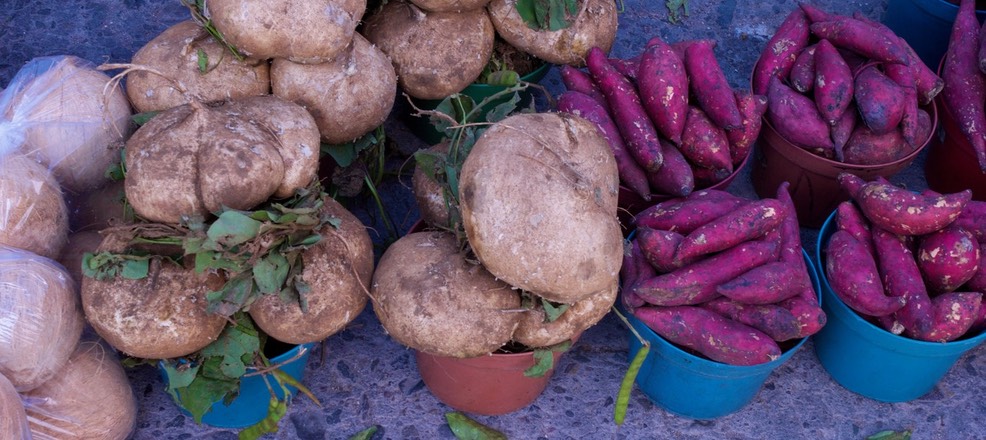
We ate at a restaurant named Mi Tierra at the edge of the market near the main highway. The food was some of the best that I have had in Oaxaca, and the service was great.
There is a church in town which is quite nice and a village square which is very restful.
We rode to the market and back to Oaxaca by taxi, at speeds which were two to three times the posted speed limit - with no seat belts in back. I never felt unsafe, but the taxi was a bit old and showing signs of wear, and highway markings did not appear to be relevant.
While milling about the market I ran into a guy who was testing the Canon 1D C (a camera which does 4K native) set to be released in mid-December. He had a nice Canon CN-E 24mm T1.5 L F Cine Lens, which happens to be a 4K lens, mounted on the camera. It was a beautiful set up. At the moment there are very few venues where you can watch 4K video, just a few movie theaters in the United States - I think.
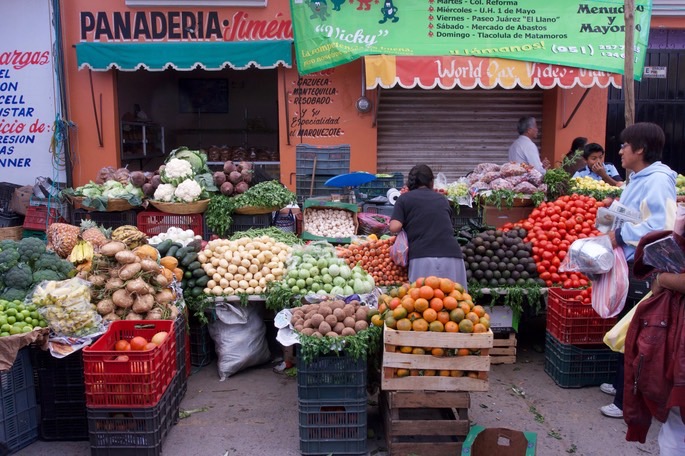
The Spanish destroyed most of the Mitla site (east of Oaxaca City), which was typical of their occupation. The Church of San Pablo, pictured below, was built on part of the ruins. The destruction of the religious icons of one culture when another culture conquers it is typical but caused me to feel more than a little remorse as I walked about. Not that I considered the Zapotec/Mixtec culture to be more noble or deserving than the Spanish - I am sure that they were responsible for their own set of atrocities - but rather that such a loss had occurred. Like the Zapotec/Mixtec architectural (and cultural?) syncretism, the Catholic Church incorporated some of the Zapotec/Mixtec motifs into the architecture of the San Pablo Church.
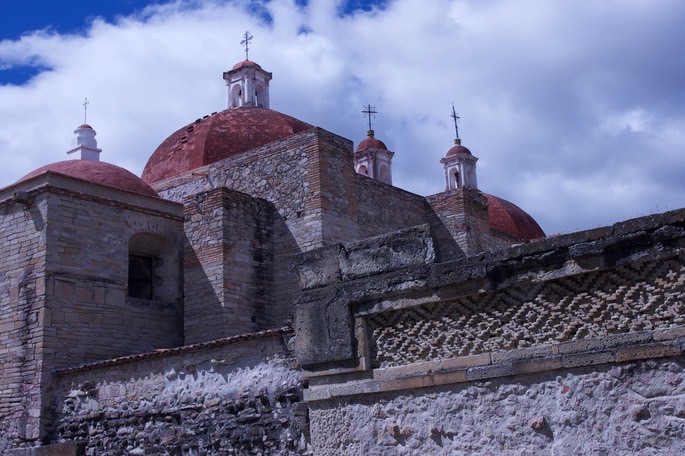
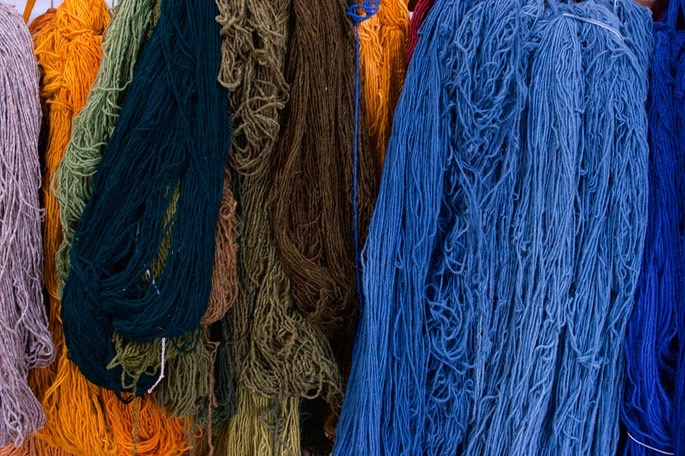
The Zapotec village of Teotitlán del Valle is known for its rug making. At that village we watched a demonstration on how the natural dyes which are used to color the wool that is woven into rugs in the area. The entire process is one of hand labor; the carding and spinning of the fiber, the dying of the wool, and the weaving which is done on large hand operated looms. Weaving first occurred in the area at about 500 BCE when cotton was used as the fabric and backstrap looms were used to weave the material. The Spanish introduced wool and the large floor looms which are used today.
The food of Oaxaca is widely considered a special treat. Indeed, there are cooking schools in abundance and lots of restaurants and carts to choose from when it comes to deciding where to eat. After a month in Oaxaca here are some of my recommendations.
Recommended:
1. Eat In. The markets of Oaxaca are full of fresh, and delicious, fruits and vegetables, and fresh bread, of multiple types, can be found in bakeries, in markets, and from street vendors. Buy some yogurt and have fruit and yogurt for breakfast.
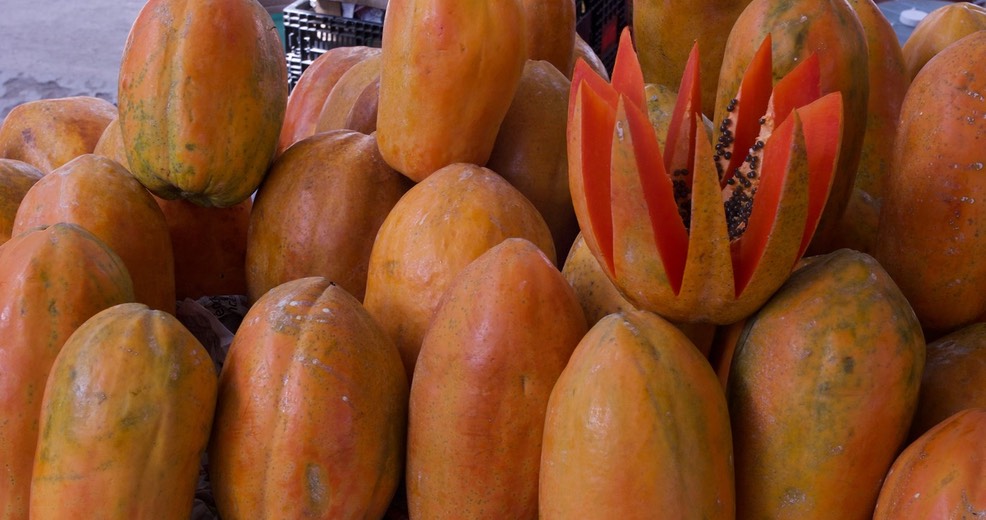
2. 1254 Marco Polo - at Llano Park. Good food, service is marginal on a busy Sunday.
3. El Andariego. The restaurant at the Parador San Miguel. Good food and good service.
4. Cafe Kandixa at 601A Garcia Vigil has nice service and food.
5. Nostrana - on Allende across from Santo Domingo. Excellent pizzas and great service.
6. 100% Natural - at Llano Park. The best breakfast in Oaxaca and good service.
7. La Casa del Tio Güero on Garcia Vigil near Cosijopi. A happy and friendly place with very good food.
8. Los Angeles at the Hotel Parador San AgustÍn serves a nice breakfast and has excellent service.
9. Café Alex at Diaz Ordaz 218 has great food and service.
10. El Asador Vasco upstairs at the corner of the Zócalo. Very nice service and very good food.
11. Mi Tierra at the edge of the market near the main highway in Tlacolula has wonderful food and delightful service.
12. Arabia Café at Reforma 117. 1960's decor and good food and service. Nice cappuccino.
13. Many of the stalls in the various markets including Llano Park on a Friday.
Not Recommended:
1. La Biznaga. Although the appetizers and soups are excellent the entrees (main dishes) are mediocre and the service is dismal and downright hostile at times.
2. SP Restaurante at 902 Independcia - with service this bad who cares what the food tastes like.